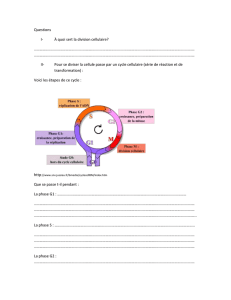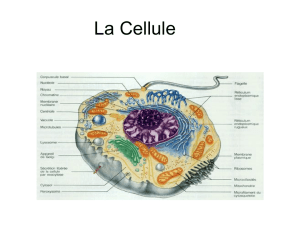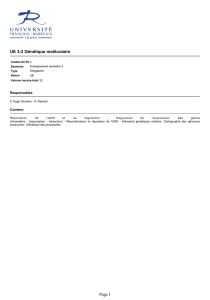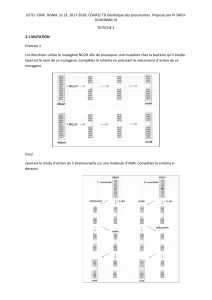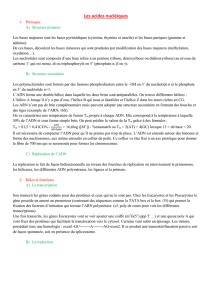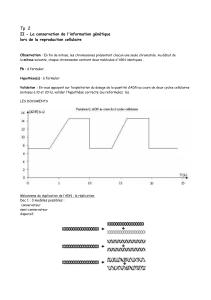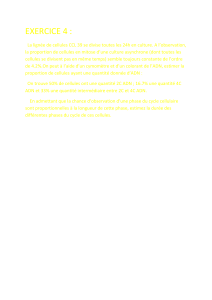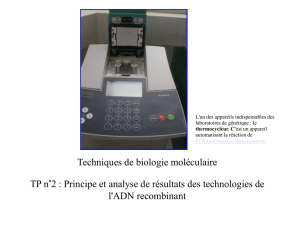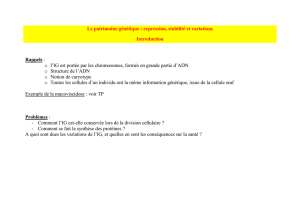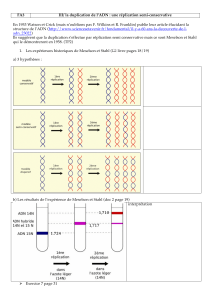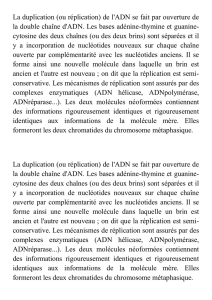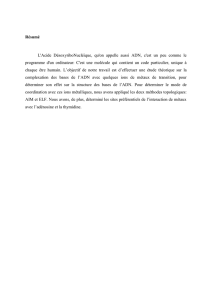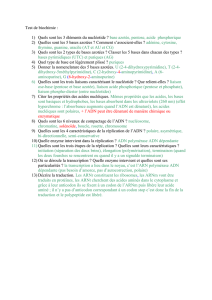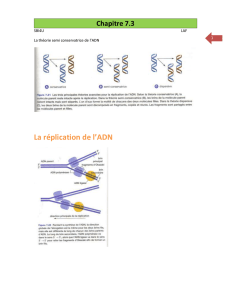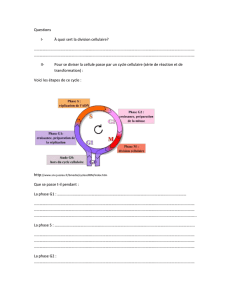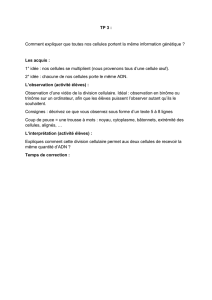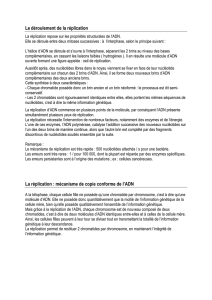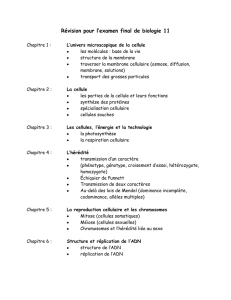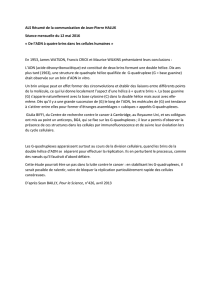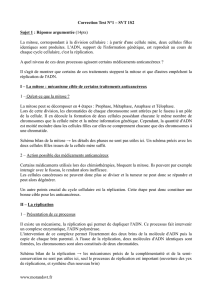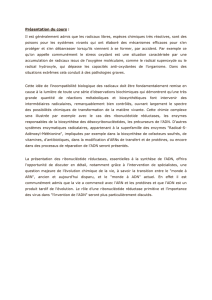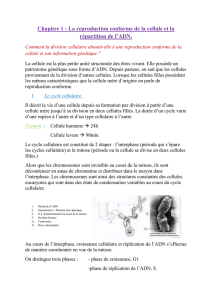La Réplication d`ADN - Fichier
publicité
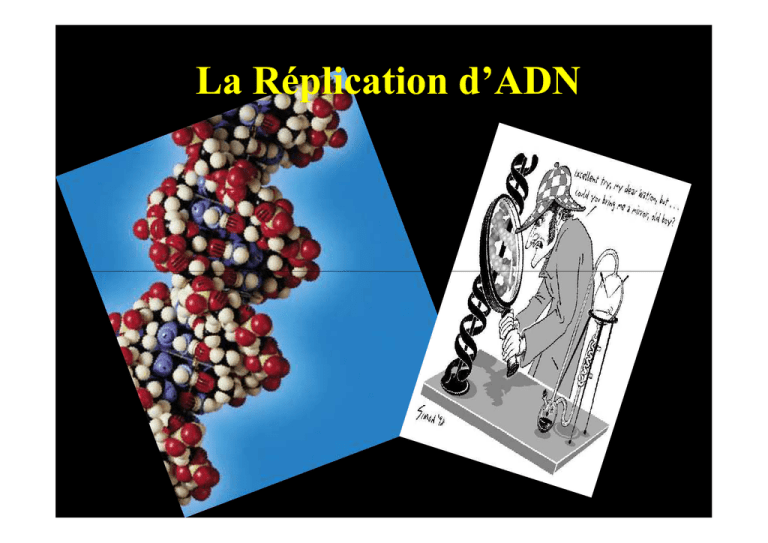
La Réplication d’ADN Réplication de l'ADN -La réplication est le processus au cours duquel l’ADN est dupliqué et synthétisé grâce à l’ADN polymérase. -Tous les organismes doivent dupliquer leur ADN avec une grande précision avant chaque division cellulaire. Ce qui permet à l’information d’être transmise d’une cellule mère à 2 cellules filles Les étapes de la vie d’une cellule Les étapes de la vie d’une cellule • Interphase • G1: phase de croissance • S: réplication des chromosomes • G2: phase de croissance – 2 centrosomes Interphase Interphase• Prophase• Métaphase• Anaphase• Télophase• Phase G1• Croissance Phase S• Croissance Réplication de l ’ADN Phase G2• Croissance Derniers préparatifs avant la division Réplication, les 3 hypothèses en compétition Initiation Origine de Réplication "Origine de Réplication" (ORI) - petits chr circulaires bactéries : 1 seule ORI - grands chr linéaires eucaryotes : 105 ORI Initiation initiation ADN poly 3 L’élongation L’élongation Topoisomérase . ADN polymérases I , Ligase . Terminaison Terminaison Les 2 points de la fourche rencontre Les ADN polymérases Bactériennes # Pol I : réparation de l’ADN. Activités 5'→3 '→3' et 3'→5 '→5' exonucléase, exonucléase, synthèse des fragments d’Okazaki. élimination des amorces d'ARN. # Pol II : réplication de l'ADN endommagée, activité 5'→ '→3 3' et activité a 3'→ '→5 5' . exonucléase. exonucléase . # Pol III : principale polymérase bactérienne de l'élongation lors de la réplication ( brin avancé et fragments d’Okazaki). Constituée de dix soussous-unités. Initiation "Origine de Réplication" (ORI) Initiation Pol a + primase +RFC ……..Amorce L’élongation Pol a + primase +RFC ……..brin dis L’élongation Pol del +RFC + PCNA ……..brin con Terminaison synthétisée par ADN Pol ε Télomérase Réparation des erreurs ADN pol. I / ADN pol. β • 1 erreur sur 100 100,,000 paires de base avant correction • 1 erreur sur 10, 10,000 000,,000, 000,000 après correction! • Mécanisme de correction: excisionexcisionresynthèse A. Altérations B. Mécanismes de réparation 2) Excision Excision--réparation de base 3) Excision Excision--réparation du nucléotide 4) Les réparations post post-réplicatives Références Cooper, Geoffrey. La Cellule, une approche moléculaire. 3e édition, 1997, ed. De Boeck Université. http://fr.wikipedia.org/wiki/R%C3%A9plicati on_de_l%27ADN ». Catégories : Réplication de l'ADN | Biologie cellulaire | ADN Références • • • • • Garg, P. et P. M. Burgers. 2005. Garg, 2005. DNA polymerases that propagate the eukaryotic DNA replication fork. fork. Crit Rev Biochem Mol Biol 40 40::115115-28 28.. Hubscher,, U., G. Maga, et S. Spadari. Hubscher Spadari. 2002. 2002. Eukaryotic DNA polymerases. polymerases. Annu Rev Biochem 71 71::133133-63 63.. Kelman,, Z. 2000 Kelman 2000.. DNA Replication in the Third Domain (of Life). Current Protein and Peptide Science 1:139139-154. 154. Johnson, A., and M. O'Donnell. O'Donnell. 2005. 2005. Cellular DNA replicases: replicases: components and dynamics at the replication fork. fork. Annu Rev Biochem 74 74::283283-315 315.. Nohmi,, T. 2006. Nohmi 2006. Environmental Stress and LesionLesion-Bypass DNA Polymerases.. Annu Rev Microbiol. Polymerases Microbiol.
